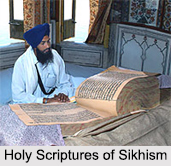 Holy Scriptures of Sikhism are primarily compiled in the "Guru Granth Sahib". It is usually regarded as the premier Holy Scripture of the Sikhs though there are some other supplementary scriptures of importance as well. The holy scriptures of Sikhism came to be regarded as the medium through which the deceased Sikh Gurus could communicate with their followers imbibing the word of God. The Sikh Gurus preached that the disciples of the Sikh faith should only worship the eternal Divine Being and not the Gurus as they were merely the representatives of God. The "Guru Granth Sahib" was recognised as a symbol of the Divine Order, meant to be honoured and not worshipped.
Holy Scriptures of Sikhism are primarily compiled in the "Guru Granth Sahib". It is usually regarded as the premier Holy Scripture of the Sikhs though there are some other supplementary scriptures of importance as well. The holy scriptures of Sikhism came to be regarded as the medium through which the deceased Sikh Gurus could communicate with their followers imbibing the word of God. The Sikh Gurus preached that the disciples of the Sikh faith should only worship the eternal Divine Being and not the Gurus as they were merely the representatives of God. The "Guru Granth Sahib" was recognised as a symbol of the Divine Order, meant to be honoured and not worshipped.
Guru Granth Sahib
Guru Granth Sahib, the Holy Scripture of Sikhism was compiled by the 5th Sikh Guru, Arjan Dev in the "Gurmukhi" script from 1603-04. This Holy Book was known as the "Adi Granth". In 1708, Guru Gobind Singh, the 10th Sikh Guru pronounced the Holy Scripture to be known as the "Guru Granth Sahib". The authentic version of the Sikh Holy Text that remains preserved today in the town of Kartarpur in Punjab.
The need to compile the teachings preached by the foremost of the Gurus, Guru Nanak and his heirs was realized by Arjan Dev upon his discovery that certain individuals were propagating their own hymns attributing them to Guru Nanak. Hence, in order to prevent the manipulation of the doctrine propounded by the Gurus and for the preservation of the sanctity of the Sikh religious faith, Guru Arjan Dev ventured to compile the teachings of the Guru. It is subdivided into 1400 parts composed of hymnical verses. These compiled verses are referred to as "Gurbani" or the "word of the Guru".
Apart from the "Adi Granth" or the "Guru Granth Sahib", there are certain other supplementary scriptures that are of immense significance in the study of Sikhism. They are as follows:
Dasam Granth
The "Dasam Granth" is composed by the 10th Sikh Guru, Gobind Singh. It is an indigenous collection of religious tenets encompassing multifarious subjects including anecdotes from the Hindu Scriptures like "The Puranas" and contemporary oral narratives. It comprises of various sections which include autobiographical segments named "Zafar-nama" and "Vichitar Natak". The importance of devout military skills is evident in the sections titled; "Shabad Hazare", "Akal Ustat", "Gyan Prabodh" and "Jap". The "Shastar Nam Mala" and the "Savaiyye" are also included in this collection. Legendary tales cover the other sections of the "Dasam Granth" like "Chaubis Avatar", "Chandi ki Var" and "Chandi Charitar" (Part I and II).
In addition, the contributions of Bhai Gurdas in the form of his "Var" or balladic compositions are also regarded as integral Sikh Holy Scriptures of Sikhism.
Janam Sakhis
A plethora of information provided by the hagiographers or "Janam Sakhis", is of huge importance in the history of Sikhism. Their accounts are considered to be of utmost magnitude within the sphere of Holy Scriptures. These involve the accounts of the "Miharban Janam Sakhis", "Bala Janam Sakhis", the "Gyan Ratnavali" and the "Puratan Janam Sakhis".
The Holy Scriptures of Sikhism are immensely respected among the followers of the Sikh faith since it is believed that the spirit of the Sikh Gurus is imbibed within the Holy Texts.









